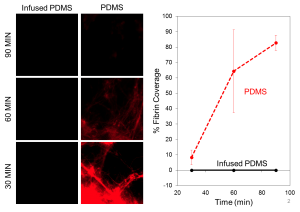Blood and Protein Interactions with Slippery Surfaces
 The interactions of proteins with interfaces is fundamental to many questions in biology and medicine. In particular, the tendency of blood to coagulate on nearly every type of surface external to the body creates a number of problems in dialysis, surgery, and other areas which have yet to be solved. Recent work has shown that immobilized liquid layers can drastically reduce thrombus formation, even in vivo. We are working to further understand the basis of this as well as apply it both to coagulation on complex surfaces as well as protein adhesion control in general.
The interactions of proteins with interfaces is fundamental to many questions in biology and medicine. In particular, the tendency of blood to coagulate on nearly every type of surface external to the body creates a number of problems in dialysis, surgery, and other areas which have yet to be solved. Recent work has shown that immobilized liquid layers can drastically reduce thrombus formation, even in vivo. We are working to further understand the basis of this as well as apply it both to coagulation on complex surfaces as well as protein adhesion control in general.
For more information, check out these publications:
Andersen, Marissa Jeme, et al. “Inhibiting host-protein deposition on urinary catheters reduces associated urinary tract infections.” Elife 11 (2022): e75798.
Sunny S, Cheng G, Daniel D, Lo P, Ochoa S, Howell C, Vogel N, Majid A, Aizenberg J (2016) Transparent antifouling material for improved operative field visibility in endoscopy. Proceedings of the National Academy of Sciences, 113,11676-11681.
Leslie D, Waterhouse A, Berthet J, Valentin T, Watters A, Jain A, Kim P, Hatton B, Nedder A, Mullen K, Super E, Howell C, Johnson C, Vu T, Rifai S, Hansen A, Aizenberg M, Super M, Aizenberg J, Ingber D (2014). A Bioinspired Surface Coating for Medical Devices that Prevents Thrombosis and Biofouling. Nature Biotechnology, 32, 1134-1140.
Sunny S, Vogel N, Howell C, Vu T, Aizenberg J (2014), Lubricant-Infused Nanoparticulate Coatings Assembled by Layer-by-Layer Deposition. Advanced Functional Materials, 24, 6658-6667.
 The interactions of proteins with interfaces is fundamental to many questions in biology and medicine. In particular, the tendency of blood to coagulate on nearly every type of surface external to the body creates a number of problems in dialysis, surgery, and other areas which have yet to be solved. Recent work has shown that immobilized liquid layers can drastically reduce thrombus formation, even in vivo. We are working to further understand the basis of this as well as apply it both to coagulation on complex surfaces as well as protein adhesion control in general.
The interactions of proteins with interfaces is fundamental to many questions in biology and medicine. In particular, the tendency of blood to coagulate on nearly every type of surface external to the body creates a number of problems in dialysis, surgery, and other areas which have yet to be solved. Recent work has shown that immobilized liquid layers can drastically reduce thrombus formation, even in vivo. We are working to further understand the basis of this as well as apply it both to coagulation on complex surfaces as well as protein adhesion control in general.